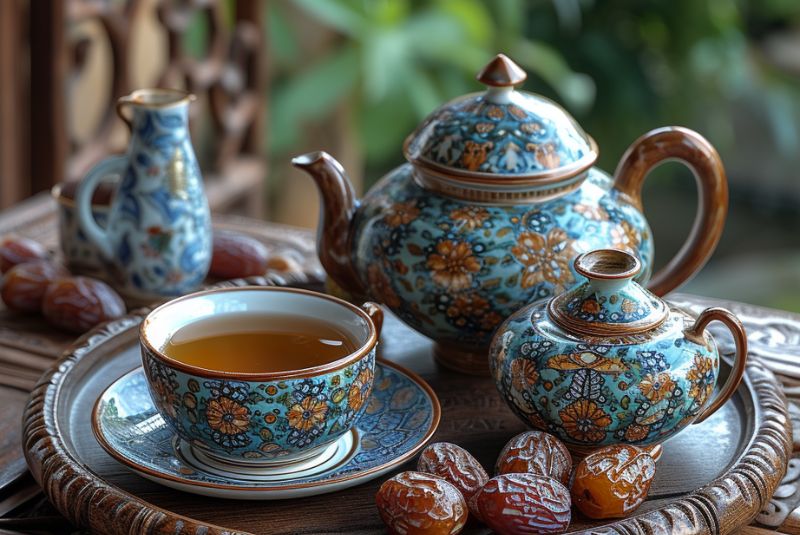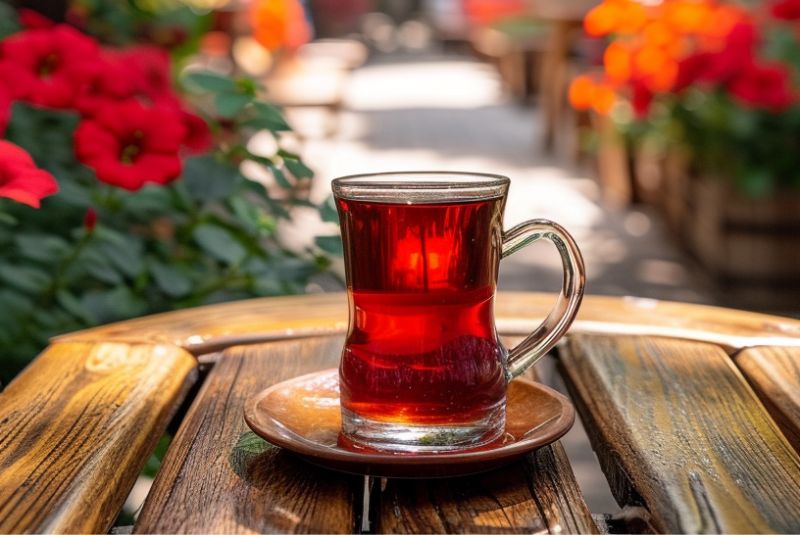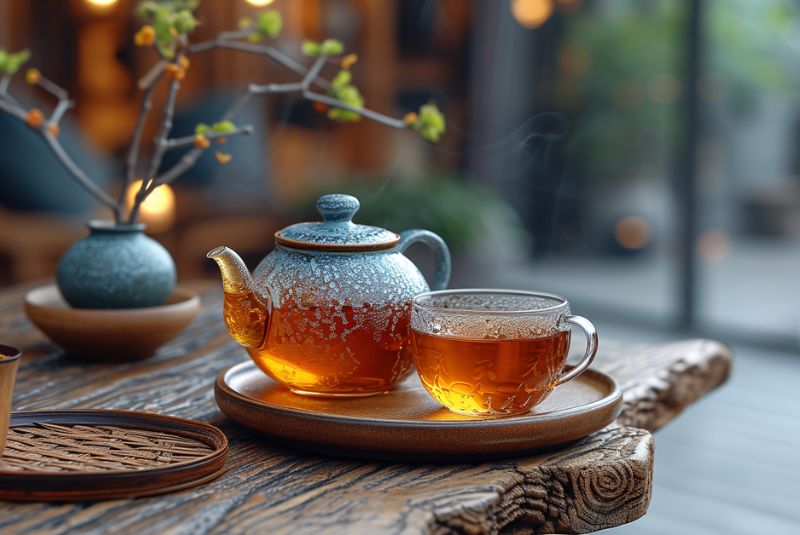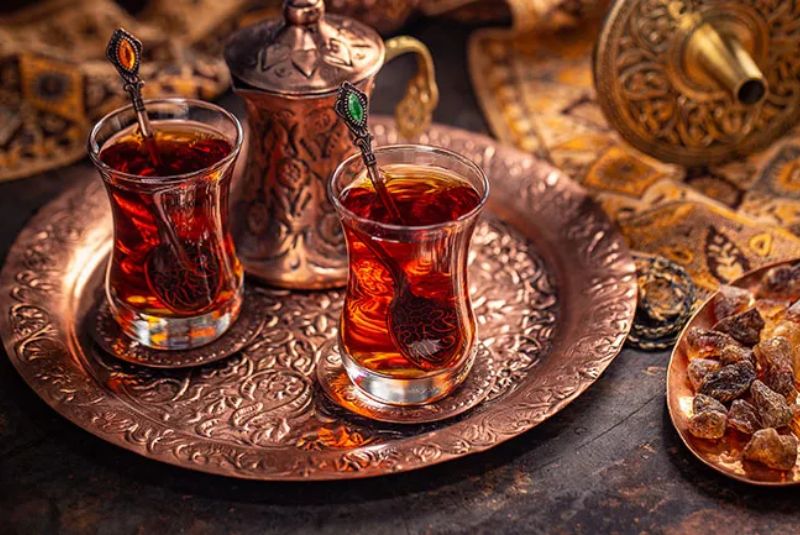Persian Tea | A Warm and Flavorful Journey
Ever craved a hot drink that's more than just coffee?
In Iran, there's a delicious tradition steeped in history and hospitality: Persian tea.
It's not just a beverage, it's a warm welcome, a chance to connect, and a flavor that will tantalize your taste buds. So, cozy up and let's explore the world of Persian tea, from its surprising origins to the way it's enjoyed in Iranian culture.
A Sip of Persian Tea History

While the presence of tea in Persia is documented as early as the 16th century, its widespread popularity began in the 19th century. The Safavid dynasty, known for its cultural flourishing, saw a rise in tea consumption, likely due to its accessibility along the Silk Road trade routes. However, reliance on imports necessitated a more permanent solution.
The pivotal figure in establishing domestic tea cultivation was Kashef Al Saltaneh (Mohammad Mirza Qajar Qovanlu), a 19th-century Iranian diplomat. His successful acquisition and introduction of tea plants from India led to the development of domestic tea plantations. Gilan province, with its suitable climate, became the "tea capital" of Iran, paving the way for the widespread establishment of teahouses across the country.
These teahouses functioned as vibrant social hubs, serving as gathering places for artists, intellectuals, and everyday people to connect over steaming cups of tea. Today, Persian tea continues to evolve. While black tea remains the predominant choice, local variations like the bergamot-infused "Persian Earl Grey" have emerged, reflecting a unique blend of tradition and innovation.
| Read more: Best Iranian Beverages and Drinks
The Varieties of Persian Tea

While black tea reigns supreme in Iranian tea culture, a fascinating array of varieties exists within this category, each having unique characteristics and experiences:
1- Chai Zarrin (Sargol)
Sargol tea stands tall as one of the most prized Iranian teas. Its name, meaning "flower tip," reflects its origins – it's meticulously crafted from the first young buds and delicate leaves of the tea plant. This premium tea steeps quickly, even faster than most other teas except ant head tea. This swift brewing process doesn't compromise its quality. Sargol tea is renowned for its distinct aroma, flavor, and taste, unlike anything found in other varieties.
The distinctive bitterness of Sargol tea is a testament to its exceptional quality. This characteristic, along with its other unique features, has earned it a reputation as the premier Iranian tea, often selected for export to other countries.
2- Chai Momtaz (Premium Tea)
Chai Momtaz occupies a prominent place among Iranian teas, offering excellent quality. While it possesses a pleasant bitterness, it falls slightly below Sargol tea in terms of overall quality.
This tea is crafted from a blend of the middle leaves of the tea plant, resulting in a unique and aromatic profile. Its price point reflects its premium status, hovering slightly above average compared to other Iranian teas.
Unlike Sargol tea, which primarily utilizes the delicate tea buds, Chai Momtaz incorporates a combination of buds, leaves, and even lower bushes.
| Want to eat Persian cookies with your Persian tea?
3- Chai Shekasteh (Broken Tea)
Broken tea leaves offer a strong, full-bodied flavor. This unique tea blend holds a special place in the hearts of many Iranians. While its name might suggest lower quality, broken tea is actually a mix of various tea leaves harvested throughout the summer and autumn seasons.
Unlike single-origin or seasonal teas, broken tea isn't a specific type or harvest. Instead, it's a carefully curated blend of different teas, resulting in a unique texture with smaller, broken leaves.
4- Chai Ghalami (Pen Tea)
Tightly rolled leaves resembling pen nibs produce a robust, concentrated brew. known for its moderate bitterness, Pen Tea falls within the mid-range of Iranian teas when it comes to price and quality. This makes it a popular choice for everyday consumption. Unlike premium teas that utilize the highest quality buds, pen tea is harvested from the lower leaves of the tea plant.
| You can also eat Persian sweets with your Persian tea!
5- Chai Barooti (Gunpowder Tea)
Also known as Chai Kale Moorche (Ant Head Tea), this type of persian tea has small, pellet-like leaves that resemble ant heads, yielding a strong, dark tea with a distinct aroma. It is popular Iranian tea often used in tea bags and instant teas.
This tea brews quickly, making it ideal for those who are short on time. However, it's important to note that Chai Barooti is typically made from the fannings, or smaller tea particles, left over during the processing of other higher-grade teas. Additionally, the final stages of tea harvesting sometimes involve collecting leftover leaves and bushes, which may also be used in Chai Barooti.
6- Chai Sefid (White Tea)
A pale, delicate tea with a subtle flavor profile. It is often described as having a slightly floral or grassy taste, making it a lighter option compared to the robust black teas commonly enjoyed in Iran.
| Suggestion: Top 20 Persian Snacks - Taste the Best
Best Time to Buy Persian Tea

The quality and character of Iranian tea vary significantly depending on the harvest season:
- Spring Tea (Chin-e Avval): The pinnacle of Iranian tea, spring tea is harvested during the first flush, typically in spring. This harvest yields the highest quality tea with a delicate flavor and aroma. Due to its exceptional quality, it can retain its fragrance for up to a year.
- Summer Tea (Chin-e Dovom): The second harvest occurs in July and produces tea of average quality. It boasts a lower bitterness than spring tea and is considered a "low-harm" option, potentially suitable for health-conscious individuals.
- Autumn Tea (Chin-e Sevom): The final harvest, taking place in autumn, generally results in tea of lower quality and flavor. This harvest often produces broken tea (anthill tea) due to the use of older leaves and bushes. While less bitter and faster to brew, autumn tea is often used in tea bags due to its color-producing properties.
| Read more: Traditional Persian Breakfast You Should Try
Persian Tea Brands: Popular Choices

While the rich tradition of Persian tea cultivation and consumption emphasizes local production, several brands have gained recognition for their quality and distinct offerings:
- Ahmad Tea
- Mahmood Tea
- Golestan Tea
- Naderi Tea
- Debsh Tea
- Twinings Earl Grey Tea
The Gilan Province, particularly Lahijan and Rasht, are widely recognized for producing the most popular and high-quality tea in Iran.
| Discover: Top Iran Fruits
How to Brew Persian Tea?

The rich tradition of Persian tea goes hand-in-hand with a specific brewing process that unlocks its full flavor and aroma. Here's a step-by-step guide to making a cup of best Persian tea:
Essential Equipment
- Porcelain Teapot: While other materials work, a porcelain teapot showcases the tea's color and flavor optimally.
- Samovar or Kettle: Ideally, use a traditional Iranian samovar for boiling water. If unavailable, a steel kettle will suffice.
- Loose Leaf Tea: Opt for high-quality loose leaf tea for the best experience.
Brewing Steps
- Boil the Water: Fill your samovar or kettle with fresh, clean water and bring it to a full boil.
- Warm the Teapot: Place the empty teapot on top of the samovar (if using) for a few minutes before adding the tea. This preheats the pot for optimal brewing.
- Measure the Tea: Add approximately one tablespoon of loose leaf tea per cup desired.
- Steep the Tea: Pour the boiling water over the tea leaves in the teapot. Cover the pot and let it steep for 15 minutes for a full-bodied flavor.
- Maintain Warmth: After 15 minutes, remove the teapot from the samovar and place it beside it. Cover the teapot with a cloth or brewing cozy to retain the heat.
| You can also brew Persian Saffron with your tea!
Tips for Perfection
- Water Quality: Use clear, filtered water for the best taste.
- Steeping Time: Adjust the steeping time to your preference. Longer steeping results in a stronger tea.
- Sweetening: Traditionally, Nabats (Rock Candy) are added directly to the cup before pouring the tea.
- Second Serving: The brewed tea can be re-steeped for a second cup, though the flavor will be milder.
Flavorful Twists
- Hel (Cardamom): This aromatic spice adds a warm, slightly sweet flavor to your tea. Add a few pods directly to the teapot while steeping.
- Darchin (Cinnamon): A touch of cinnamon adds a warm, woody note to your tea. Add a cinnamon stick to the pot while steeping.
- Side Snacks: Traditionally, Persian tea is enjoyed with side Ghand (Sugar Cubes), Toot Khoshk (Dried Mulberries), and Keshmesh (Raisins).
| Also read: Famous Iranian Desserts
Final Takeaway
So, next time you're seeking a warm and flavorful drink with potential health benefits, consider a cup of Persian tea. For the most authentic experience, consider enjoying a cup of Persian tea in its homeland, Iran.
Share your story!
Comment below and let us know about your Experience.
Your story inspires others!


Comment
Leave a Comment